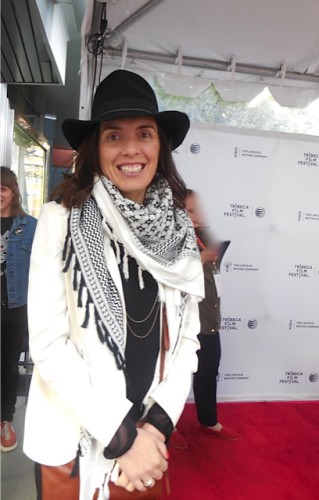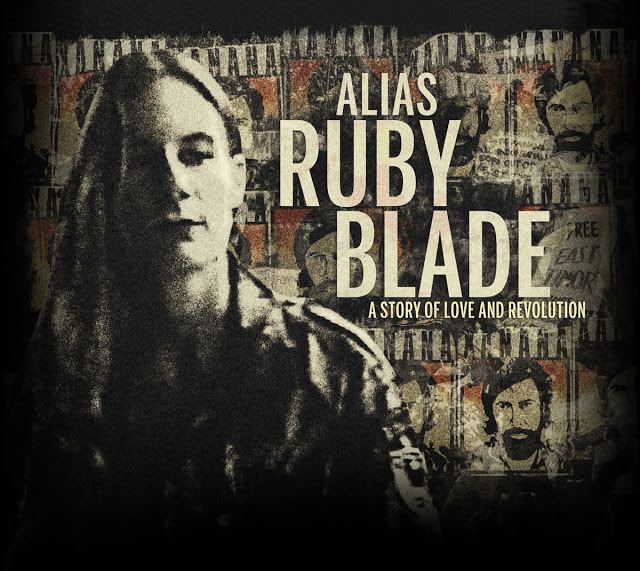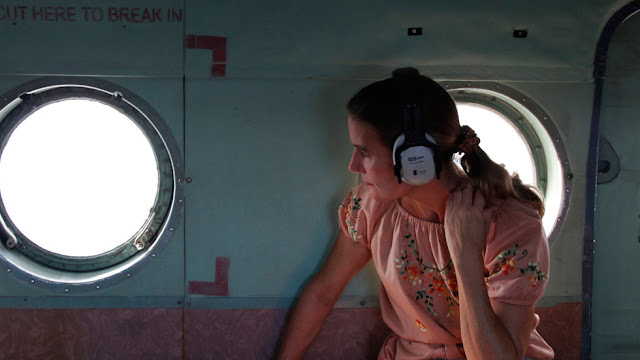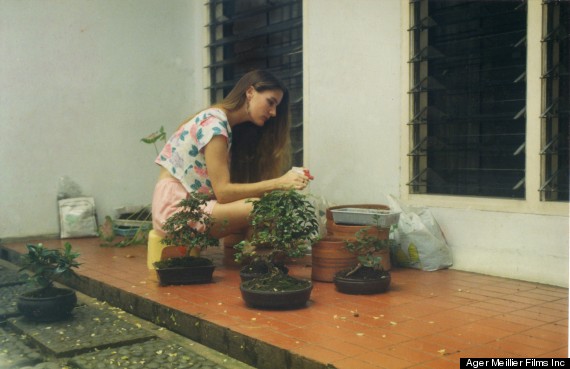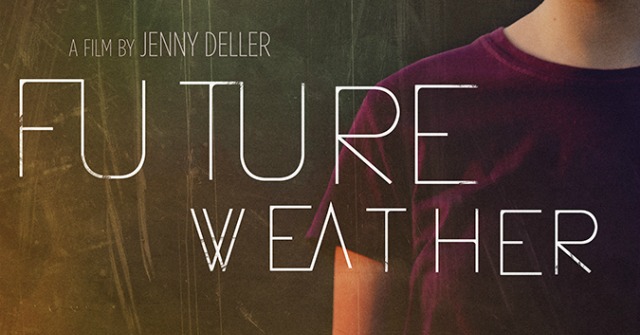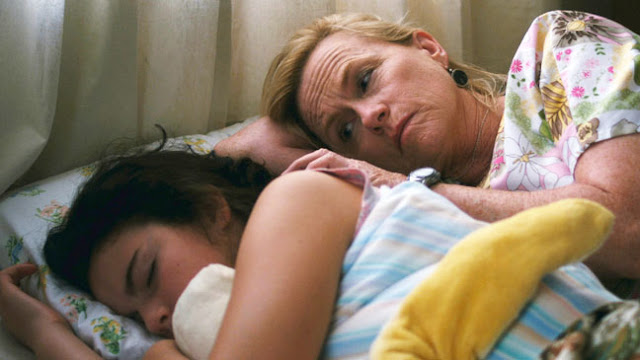
This is a guest post by Paula Schwartz.
Bleeding Heart, written and directed by Diane Bell, stars Jessica Biel and Zosia Mamet as two sisters who have never known each other. Biel plays May, a reserved and disciplined yoga instructor who has enlisted a private investigator to help her track down her long-lost biological sister, Shiva (Mamet). She discovers her younger sister is a prostitute in an abusive relationship with a boyfriend who is also her pimp. May feels protective and driven to rescue Shiva from her chaotic and dire financial and personal situation.
Bleeding Heart begins as a character study of two very different women and turns into a revenge thriller. The movie features two strong female roles by actresses who are usually typecast. A deglamorized Biel get a chance to show of her acting range instead of coasting on her looks, while Mamet is convincing as a hooker with a heart of gold trapped in a toxic relationship, a role world’s away from the whiny, privileged Shoshanna she plays in Girls.
The cinematography is particularly beautiful, especially in an early scene where May is practicing yoga and her body is framed by a gorgeous Los Angeles sunrise. In a shot that feels like it could only be directed only by a woman, the camera pans over every part of Biel’s body as she does her yoga routine and rather than sexualizing her, reveals her strength and power, something May is not even aware of at that moment.
Bleeding Heart recently premiered at the Tribeca Film Festival, which screened 119 features, of which only 30 were by women filmmakers. Bleeding Heart was one of 12 narrative films by women directors screened. This is an improvement over the previous year but not good enough. (Biel, who is married to Justin Timberlake, had just given birth to a baby boy and was unable to make the movie’s premiere at Tribeca.)

During the festival I met with Bell at a restaurant in the Meatpacking district to chat about her film and following are edited highlights:
Talk about the opening shot of the film, where Jessica is practicing yoga and the sun rises. The camera focuses on different parts of Biel’s body and it feels like only a woman filmmaker could get a shot like this.
This is why we need more female filmmakers, because it’s a different perspective. Everyone’s got a different perspective, and we have different stories and different ways of looking at the world. I feel that the stories we have on film just don’t reflect our reality; they also create it. They also change how we see things.
I was very blessed with Jessica that when she got onboard the film she probably had about three months in which she completely immersed herself in the yoga practice.
Jessica hadn’t done much yoga before the film?
She’d done some yoga but like I was very specific with this film that she’s an Ashtanga Yoga practitioner, which is what I taught and which I practiced, so she immediately started practicing Ashtanga every single day. And she started working out in the gym. She completely committed to it and she became vegetarian, and she went the whole way with it.
The thing that’s different with Ashtanga than with other kinds of yoga is you do a self-practice. You learn the sequence of positions and you do them. So when she came to shoot it she knew the sequence… I’ve done it every day for 15 years or something. We knew what it was that we were doing. And I think the thing that really comes across in those scenes is her level of concentration. She’s in that zone.
And Zak (Mulligan) and I, my DP, was just phenomenal, and we knew the kind of lighting that we wanted. The film both starts and ends with that moment of dawn, of the sun coming up. Ashtanga yoga is typically practiced in the very early mornings so ideally you’re practicing from when it’s dark until when it’s light. And that was something that was really important to me, so in the opening sequence it goes back and forth between her teaching a class and also her doing her own practice. When she’s doing her own practice, it’s just that cool light of like pre-dawn, before the sun comes out when it’s a little bit blue. And then when she’s teaching, it’s light and it’s just past the sun coming out. And that’s typically what Ashtanga teaches.

Jessica Biel is usually typecast, especially in roles that focus on her looks and being sexy. In the film she hardly wears makeup and her hair is pulled back in a simple ponytail. Were you worried she’d be able to pull this off?
My concern when she was suggested was that she’s so glamorous. My impression was that she’s so perfect and glamorous and I didn’t think she’ll be able to do this, you know, and the first thing she said to me when I met her was, “I understand May because everybody thinks my life is perfect, but I’m a human being.” I asked her if she would be happy to have no make up and she said, “100 percent.”
What was your production schedule?
We shot the film in 19 days, 12 hours a day normally. As a director I will not go over time. It’s not fair to cast. 12 hours a day is plenty for everybody, and I’m absolutely rigorous, being lucky in both my films working with great first ADs, and then just absolutely rigorous about just keeping it going and keeping that momentum and getting our days every day.
Talk about the chemistry between Zosia Mamet and Jessica Biel since that is crucial for the story since it focuses on their relationship.
Everybody connected and bounded very quickly. And I think a lot of friendships came out of the film. I know Zosia and Jessie became really close. They didn’t know each other before, but the moment they met, and this is one of those things, you just say, “Oh my God, I’m so lucky!” They really clicked. They somehow brought out something great in each other. On set, as human beings too, they just had that connection. They were just like sort of goofy together. There were lots of laughs and you could see they had a bound.
Did you test them together?
No. The funny thing about that sort of chemistry between people, like I feel the movie is partly a love story. It’s about these two women falling in love with each other. And I knew it had to have that chemistry. It’s just like a love story. There’s got to be that sort of spark and I feel they really had it. I felt it every day on set. The two of them together are so charming and sweet and funny.
In the film their characters are both controlled by men although in different ways. Shiva’s boyfriend is her pimp, and he is violent and abusive, while May’s partner is gentle and good to her, but he also tries to control her life. Talk about that.
It was just something that I was interested in. There’s explicit violence and then there’s sort of like another kind of violence, which is sort of implicit.
May’s boyfriend wouldn’t identify himself as being a controlling person and would hate to think of himself as that, and she wouldn’t think of herself as being in that relationship, but that’s what they are. Those are the mechanisms of their relationship and that was definitely something I kind of wanted to say of these two women. They’re two opposites, yin yang, but they’re really the same.

In the production notes it says you are fascinated by violence. What do you mean?
There’s so much of it in our society. How do we actually deal with it? I don’t like violence at all. I absolutely detest it. I’m a complete pacifist. And for me one of the questions driving this film from my perspective was, okay, if you’re completely committed to peace, it’s easy to be peaceful if everyone around you is peaceful. It’s super easy, it’s great. But what if you have to deal with somebody who’s really violent? How far do you go to help someone, protect someone from someone who’s really violent?
In our society domestic abuse and the murder of women by spouses or boyfriends are epidemic. And it’s something we don’t want to talk about. I looked up the actual statistics of it before coming here because I thought, I better get it right. In my head I thought it was about 30 women a month are killed in America by their partners right? That was the figure I had in my head. I looked it up. It’s really three women a day. On average spouses or ex-boyfriends are killing three women everyday. That’s an epidemic!
What is your next movie?
The next one I’m going to shoot in July. We’re Crowdfunding right now in a totally off the grid way. It’s a micro-budget movie. It’s called Of Dust and Bones. It’s about a widow of a war journalist and her husband was killed in Syria. She had decided to just retreat from the world. She lives a monastic kind of life in the desert where she wants no part of what she views as this crazy world, basically. Then her husband’s best friend and colleague, Alex, who actually sent her husband to Syria, comes to visit her. He has come with an agenda. He wants the rights to her dead husband’s last photographs. She feels very strongly that there’s no hope to be good in this world and every time we try to make things better we actually end up making things worse creating more suffering. The film is about what unfolds between them in the desert over these days. It’s these two wildly different viewpoints clashing.
See also at Bitch Flicks: “Vive La Revolution!” by Diane Bell
